

The well-known, well-respected (and sought-after) Farfisa Compact line includes the Mini-Compact, the Compact, the Compact Deluxe and the Compact Duo. In true combo-organ style, there is more than one version of each, all of which are described below. Some clues to their dates are available in advertisements, brochures, price lists and service manuals. Some versions definitely seem to have preceded others, but pinning a particular model down to a range of dates is difficult, and there certainly was some overlap in production. The Compact line was available from roughly 1964 until about 1970.
Sound: The Compacts filter their sounds in a somewhat different manner from most other Combos, and the Multi-Tone Booster, with its own distinctive sound, is an integral part of what gives the Compacts "that Farfisa sound". Kirk Slinkard expounds a bit on the subject:
"Where Vox and others start with a square wave (50% pulse wave) and filter it a little for the brighter voices and filter it down a lot to get flute or sine wave voices, Farfisa's MULTI-TONE BOOSTER starts with its unique 67% pulse wave filtered down into a sine wave, and as you move the knee lever or add the ALL BOOSTER switch, a heavily HIGH-pass filtered pulse wave is added to the sine wave. On an oscilloscope, it looks like a narrow spike is stabbing down into the top of the sine wave, slightly off to its right side. This gives the Compacts their different sort of bright sound which can get brighter and more raucous than most other brands."
Colors, plastic tops: From what I've been able to find, it seems that all Minis, Deluxes and Duos came in the same light Beige color, almost a Grey when new, but I'll stop short of calling it that. Most seem to have faded/yellowed over time to almost a tan color. The basic Combo Compact, all versions of it, came in both Red and Grey (actual Grey, which remains Grey in current specimens), with Red seeming to be the more common color (so don't let anyone tell you that Red is the rarest color!). I've heard from a few people who claim to have seen Compacts in Green. I've never seen one myself (except one or two that were obvious aftermarket paint jobs), but it's kind of hard to discount when you hear the same story from multiple sources - some on opposite sides of the Atlantic!. Maybe the grey/beige ones had just enough green to fool the color-blind among us.
The plastic tops on all versions of the Combo Compact, except the last, were a smooth, shiny finish. The last Compact version, the Compact I, had a top with a textured finish, as did all versions of the Deluxe Compact. Typically, I've heard from at least one person who has seen a basic Compact with a textured top - yeah, with Combos, the only rule is that there are ALWAYS exceptions!
Reverb: I got this tidbit from Mike (who asked not to be credited), who actually worked for Farfisa when the Compacts came out, and he had this to say about the Reverb: "Tube preamps were used where the spring reverb was used. To overcome Hammond's patent we made our own units, using piezoelectric transducers instead of magnets, and this required 100V plus drivers, at the time not easy to have with transistors."
Registrations:
A few folks on the Discussion Group mentioned their favorite Compact registrations:
Strings 16', Flute 8', Trumpet 8', Flute 4'
Bass 16', Trumpet 8', Flute 4', 2 2/3'
Bass 16', Flute 8, Trumpet 8, Piccolo 4
Bass 16', Flute 8, Trumpet 8, Strings 8'
Bass 16', 2-2/3'
Bass 16', Flute 8', Oboe 8', Flute 4' (use with Fast Vibrato for "When a Man Loves a Woman")
Bass 16', Strings 8', Strings 4' (and use the volume pedal to add a decay envelope for a pseudo-Harpsichord sound)
Click on one of the links below to go to the section of this page that deals with a particular model. I've included a section for the oft-asked-about Compact Volume Pedal, and a bit on the Bass Pedals, as well.
Little-brother to the Compact, the Mini offers a good compromise between features and size/weight. There are three flavors of the Mini: The basic Mini Compact, the Mini Deluxe, and the Mini Deluxe I. The latter two are actually Farfisa designations I've gleaned from literature, but all sport only the name "Mini Compact". Those that have a model number on their ID plates list it as "Mod. MC/3 = MINICOMPACT" The word "Deluxe" never appears anywhere on the organ, as far as I know.
The Minis circuitry is very similar to the regular Compacts, and they can achieve pretty much the same palette of sounds as their larger brethren
Volume pedal/Knee Lever: All the Minis feature the famous Multi-Tone Booster and Knee Lever. In the Mini, however, the Knee Lever performs the dual function of Booster level and Volume control, even with the Booster tabs switched on. With the lever in normal position, the volume is very low, prompting many Mini (!?) owners to come up with a way to fasten the lever in its fully-pushed position. Thankfully, an optional volume pedal (identical to the one used for the larger Compacts) remedies the situation. When plugged in, the pedal performs normal volume control functions, freeing the lever to concentrate on its more natural function of adding in the Multi-Tone voices.
Mini Compact (first version)
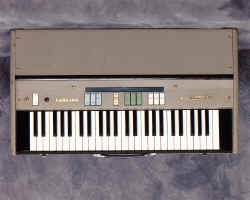 |
The earliest, most basic of the Minis, introduced, I believe, in late 1965. (I know at least one person who bought one of these new in December,1965) |
(Pictures courtesy of Kirk Slinkard)
This version sports three voices, in three ranks (16', 8' and 4'), plus the Multi-Tone selector. Satisfied Mini owner, Patrick P, describes the interaction between these tabs:
"The footage tabs are actually associated with the voice tabs and the multi-tone booster. With MTB off, if all the footage tabs are off, you won't get any sound, regardless of which voice tabs are engaged. With MTB off, if you engaged 16', 4', dolce, and string, you'd hear 16' dolce, 16' strings, 4' dolce, and 4' strings. You can really get a fair number of decent sounds out of the li'l guy"
Controls:
The Mini-Compact has a volume pedal cable with a DIN plug on the end, just like a Compact. I'm not certain of this, though - some may not have this cable. I don't think any of them have the DIN jack on the underside of the organ, like the Mini-Deluxe (below)
Mini Deluxe Compact (second version)
(Pictures courtesy of Kirk Slinkard)
(Pictures courtesy of Sandy Alexander)
|
Controls:
|
Here's a sales flyer for the Mini-Deluxe:
|
Mini Deluxe I Compact (third version)
Controls:
Here's a sales flyer for the Mini-Deluxe I:
The venerable Farfisa Compact is, next to the Voxes, probably
the best known combo organ around. The Compact is
one of the few combo organs that actually uses tubes (valves). Both the
Compact and the Compact Deluxe have tubes, which are used primarily for the
Reverb circuit. Richard B. explains:
"They needed the
tubes to drive the 'ceramic phono cartridge' reverb spring on the Compact
and the Deluxe. Back then high voltage transistors were really expensive.
That's why compacts and deluxes have tubes but minis, duos or the Fasts
don't."
Minis, Duos and Fasts don't have a built-in spring reverb, and so
don't require tubes (the Duo's reverb is outboard in the F/AR unit). The Compact uses two
ECC83s, and one half of one of
them (they're twin-triode tubes) is used in the preamp circuit. Many Compacts have a sticker
that says “Electronic Transistorized”, but this does NOT indicate that the
model is tubeless, just that it has transistors, like virtually every
other combo organ around.
One frequent point of confusion with the Compact is the 1/4" jack near the power switch (on the left side of the keyboard). This is a headphone jack, but not for any pair of headphones you're likely to have laying around - it's meant to drive a very high-impedance style of headphone, about 2,000-4,000 ohms impedance. I think you can actually plug it into an amp and get a usable signal, though. The normal signal output is (in typical Farfisa fashion) via a hardwired cable with a 1/4" plug that comes out underneath
Different versions: There are a few different versions of the basic Compact. All of these are designated simply "Compact", and all have either "Mod. CC / 23 = COMPACT" or no model designation at all on their ID plates
Regarding colors: Despite rumors to the contrary, a Red Compact is NOT a rarity. Red is definitely the most common color for the basic Compact, with Grey running a close second.
I've found three different versions of the Compact (and one very minor variation). I'll present the most commonly seen one first, and the others afterwards
Combo Compact (second version)
And here's one with its plastic music rack still intact (a somewhat uncommon occurrence):
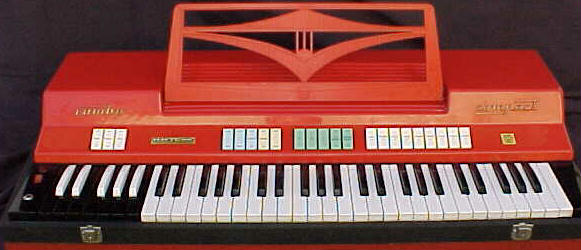
Controls:
Bass Volume: Bass
f, Bass ff, Bass fff
Vibrato: Slow/Fast, Light/Heavy, Vibrato Off/On
Reverb: Reverb Off/On, Med/Long
Multi-Tone Booster: 16', 8', 4', All Booster Off/On, Multi-Tone Booster
Off/On
Voices: Bass 16', Strings 16', Flute 8', Oboe 8',
Trumpet 8', Strings 8', Flute 4', Piccolo 4', Strings 4'
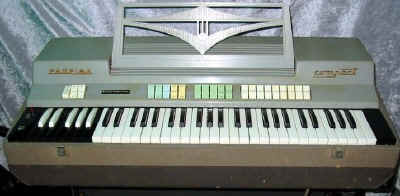 |
Another nice example in Grey, with a very minor, but unusual variation. Note the gold lettering on the plastic top - "FARFISA ... compact", rather than the MUCH more common "combo ... compact" Henry Badowski tells me that all of the Compacts he's seen in the UK have this wording. From my (far more limited) experience, I'd tend to agree. The one shown here found its way to Australia. (picture courtesy of Melbourne Music) |
Rear control panel
 |
This rear panel is pretty standard among the basic Compact. The "Pedal" volume and output are for the bass octave, whether or not pedals are used. |
ID Badges
The first six ID Badges pictured below are from a standard Compact. There are 2 main styles. The ones on the left are, I believe, older than the ones on the right.
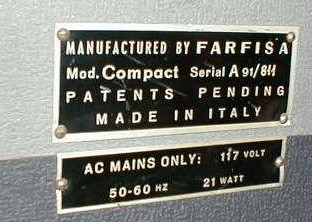
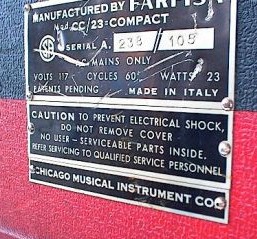
Here's a weird one I had never seen before. Note the Model name of CC/21. Every other plate I've seen was CC/23.
And here's the organ it came from. It's the standard "second verson", but is from the UK, and has the words "FARFISA" and "Compact" on the red top.
(Thanks to Martyn for the CC21 pictures)
Combo Compact (first version)
This is the first version of the Compact, from 1964 or possibly late 1963. In the "Compaction" brochure, this model appears alongside the earlier versions of the Mini-Compact and Compact Duo. The copy I have has "12-65" hand-written on the front. I have, however, seen one of the later models (above) with the 5 green tabs, that was purchased new in 11/65, so perhaps there was some overlap. In the "meet the combo compact" booklet, also dated 1965 (no month), this version is shown, along with the first versions of the Deluxe and the Duo (but with the 2nd version of the Mini - the Mini-Deluxe), but on the "Control Panel" page, the Multi-Tone section includes the "All Booster On" tab. (confusing, eh?)
I don't have any really good pictures of this version, but except for the control panel, it looks just like the 2nd version (above)

The main difference is that it has only 4 green Booster tabs - it’s missing the “All Booster On” tab, sort of like the Mini Compacts. This version typically has the older style ID badge (see above), and the rear control panel is different, lacking the separate output jack and volume knob for the Bass section, and replacing the fuse holder with a voltage selector (see pictures below: One other difference that's been reported a few times is that this model does not have the holes in the top where the music rack would attach.


This is an ID badge from one of the first versions.. It's like the other "early" Compact plates shown above, but it includes the middle two lines showing the AC power characteristics.
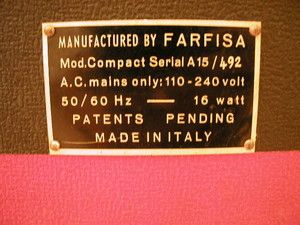
Combo Compact (third version?)
A really odd bird, the example below is the only one I’ve seen. It has an extra white tab between the yellow Reverb tabs and the green Tone Booster tabs. It’s labeled “Pedal Off/P”, and switches the 2nd octave to play bass notes as well. And if that's not unusual enough, the 2nd octave is normal-colored, not Grey/White like on the Deluxes. If I had to guess, I'd say this was the third version,
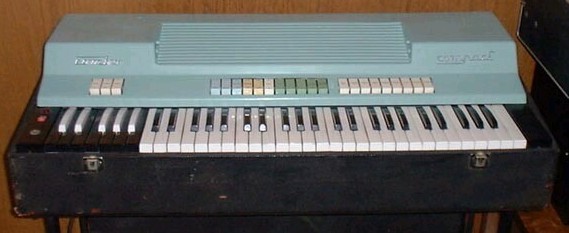 |
(The
owner of this one assures me that it's been painted - they didn't come
in this color)
|
Combo Compact I
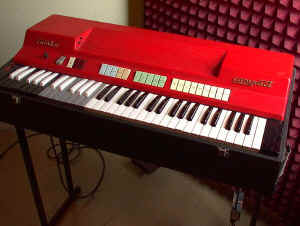
And here's a nice red one |
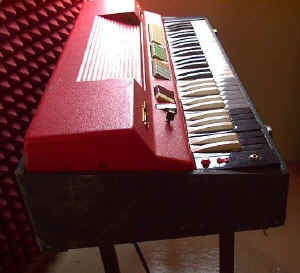
Note the textured plastic top. This is the only version of the Compact that has this type of top - all the others are smooth. |
Rear
control panel: I've only seen a few pictures, but they don't seem to be
consistent. Some appear to be like the Compact (second version), with the
4 knobs and output jack, like this.... ,
and some are like the Deluxe, like this:
,
and some are like the Deluxe, like this:![]()
Controls:
The knob and first 4 tabs are different, the rest is the same as the Compact (2nd version)
Bass
Volume: The three tabs have been replaced by a single knob
Gray Keys Selector: Treble/Bass
Pedal Bass Manual: Soft/Sharp
Percussion:
Percussion
Treble Off/On, Percussion Long/Short
Vibrato: Slow/Fast, Light/Heavy, Vibrato Off/On
Reverb: Reverb Off/On, Med/Long
Multi-Tone Booster: 16', 8', 4', All Booster Off/On, Multi-Tone Booster
Off/On
Voices: Bass 16', Strings 16', Flute 8', Oboe 8',
Trumpet 8', Strings 8', Flute 4', Piccolo 4', Strings 4'
The Compact Deluxe was more than just an additional version on the Compact - it had its own name and model number designation - "Mod. "CC / 26 - COMPACT deLUXE", as reported by the typical ID badge.
Like the Compact, the Deluxe came in 3 versions, again, all sharing the same model name/number.
Combo Deluxe Compact (first version)
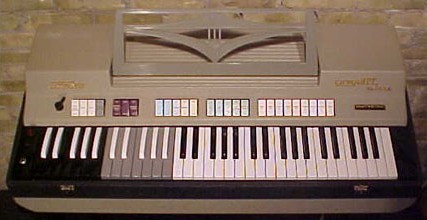 |
I think this one came out in
1966. To the features of the Compact, it adds the 2nd octave
of grey bass keys, a Soft/Sharp selector for the Bass section, and
Percussion, selectable for Bass and/or Treble.
Except for the Pedal p and Pedal f tabs, and the the Percussion Bass tab, this one is identical to the Combo Compact I. |
Note that, while there's a Bass Volume knob, it seems that two of the Bass Volume tabs from the regular Compact have returned - sort of. The Pedal p tab lowers the volume of the Bass octave, and the Pedal f tab raises it - so with this one you've got not one, but TWO completely different methods of altering the volume of the Bass octave - wow, the mind just reels with the dizzying array of possibilities afforded by this arrangement!
Controls:
Bass Volume Knob
Pedal Bass Manual Soft/Sharp
Pedal Off / p, Pedal Off / f
Grey Keys Selector: Treble/Bass
Percussion Tabs:
Percuss. Manual Bass Off/On, Long/Short, Percuss. Treble Off/On
Vibrato Tabs:
Slow/Fast, Light/Heavy, Off/On
Reverb Tabs:
Off/On, Med/Long
Booster Tabs: 16', 8', 4',
All Booster Off/On, Multi-Tone Booster
Off/On
Voice Tabs: Bass 16', Strings 16', Flute 8', Oboe 8',
Trumpet 8', Strings 8', Flute 4', Strings 4', Piccolo 4'

Combo Deluxe Compact (second version)
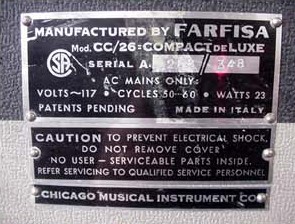
Typical ID badge |
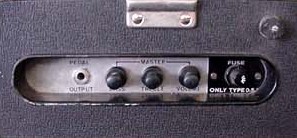
Typical rear panel - has the Bass and Treble controls, like the standard Compact, but no separate Pedal Volume knob. Typical for both Version 1 and Version 2 |
Controls:
Bass Volume Knob
Pedal Bass Manual Soft/Sharp
Pedal Off / p, Pedal Off / f
Grey Keys Selector: Treble/Bass
Percussion Tabs:
Percuss. Manual Bass Off/On, Long/Short, Percuss. Treble Off/On
Vibrato Tabs:
Slow/Fast, Light/Heavy, Off/On
Reverb Tabs:
Off/On, Med/Long
Green Booster Tabs: 16', 8', 4',
2-2/3', All Booster Off/On, Multi-Tone Booster
Off/On
White Voice Tabs: Bass 16', Strings 16', Flute 8', Oboe 8',
Trumpet 8', Strings 8', Flute 4', Strings 4', 2-2/3'
Brilliant Tab
Tabs - click on the picture for a larger view
Combo Deluxe I Compact
(Many thanks to Morgan Fisher for these excellent pictures of his Deluxe I Compact)
Controls:
3-position slider switch. Sends
Cymbal and Drum sounds to Black keys, Grey keys, or both
Effects Tabs:
Brush Cymbal, Drum
Bass Volume Knob
Pedal Bass Manual Soft/Sharp
Grey Keys Selector: Treble/Bass
Percussion Tabs:
Percuss. Manual Bass Off/On, Long/Short, Percuss. Treble Off/On
Vibrato Tabs:
Slow/Fast, Light/Heavy, Off/On
Reverb Tabs:
Off/On, Med/Long
Green Booster Tabs: 16', 8', 4',
2-2/3', All Booster Off/On, Multi-Tone Booster
Off/On
White Voice Tabs: Bass 16', Strings 16', Flute 8', Oboe 8',
Trumpet 8', Strings 8', Flute 4', Strings 4', 2-2/3'
Brilliant Tab
The Big Kahuna of the Compact line, the Compact Duo (Mod. "CD /30=COMPACT Duo") has all the features of the Deluxe (second version), plus a whole 'nother keyboard on the bottom! The lower manual has the two bass octaves of the Deluxe, and a meager selection of three voices (at least they're not all 8', though). There's actually a bit more than that to be had - you get the cool red lights under the top keyboard, and the later version added Tremolo and Percussion to the arsenal. Plus, one version of the Duo has a mixture tab not found on any other Compact!
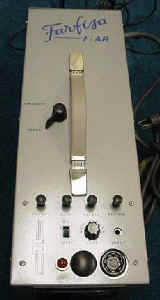 |
The Duo is a bit unusual, in that its
power supply, preamp and reverb unit are all contained in an outboard box,
the F/A-R, shown here (I believe the letters stand for
"Farfisa/Amp-Reverb"). Why they chose to do it this way is anybody's
guess, but it's been trouble for would-be Duo owners these days, since
many a Duo has been separated from its F/A-R over the years, Still, unlike
combo organ legs, a great many of these little beasties have managed to
remain attached to their benefactors. And since they were also used
with the Transicord accordion, there apparently are a fair number of them
still around, and can often be found by themselves on eBay, though
typically not cheaply.
Fortunately, however, the power supply portion (the really critical part) is relatively easy to duplicate (unlike that wretched Gibson G201 amp/power supply!), being basically just a single-voltage DC power supply and a couple of wires for the audio output (well, it's also got a 9VAC output for the volume pedal bulb). Click here for more information, including a schematic The F/A-R included a full-size Hammond-style reverb tank, which does not need to be driven by tubes, so it's a fully-transistorized unit |
Unlike its lesser brethren, The Duo, was only available in a paltry two versions, detailed as follows:
Compact Duo (first version)
Controls
Percussion: Off/On,
Long/Short
Pedal: pp, p, mf
Vibrato: Slow/Fast, Light/Heavy, Vibrato
Off/On
Reverb:
Off/Off
Multi-Tone Booster: 16', 8', 4',
2-2/3', All Booster Off/On, Multi-Tone Booster
Off/On
Voice Tabs: Bass 16', Strings 16', Flute 8', Oboe 8',
Trumpet 8', Strings 8', Flute 4', Strings 4', 2-2/3' - 2'
Brilliant Tab
Grey Keys Selector: Treble/Bass
Lower manual voices:
Dolce 8’, Principale 8’, Ottava 4’
Knobs: Bass Manual Balance, Lower Manual Balance
The last white voice tab is actually a mixture of 2' and 2-2/3' footages. Apparently, this mixture voice is not filtered to be as "soft" as the 2-2/3' tab on the Deluxe (or the other version of the Duo, below), and can be used to produce a more "Vox-ish" sound. I'm told this version of the Duo was the one Rick Wright used on some of the earlier Pink Floyd albums, and that "See Emily Play" is a good example. As in the Deluxe, the Brilliant tab affects only this mixture voice.
Rear Panel: There isn't one! All the output controls are on the F/AR!
Lights: The three lights under the top
keyboard are as follows:
First: Always on
Second: Lights up when the Grey Keys selector is set for
Treble
Third: Lights up when the Grey Keys Selector is set for Bass
(and the 2nd one goes out)
So you can think of them as delimiting the range of the bass section - the first
two on indicate the Black keys are Bass, and the first and third on indicate the Black
and Grey keys are bass. A good picture of these lights is included in with
the next version of the Duo, below.
If that's too complicated, try Henry Badowski's suggested
description: "...it has three crazy lights
that
move around when you flick one of the switches"
Yeah, now that makes sense!
Sound Samples!
These are courtesy of Antti Pitkämäki:
Demo1: 16' multitone-booster with all-booster on
Demo2: Same riff, but 16' and 8'
Demo3: Same riff, but 16', 8' and 4'
Demo4: Same riff, but 16, 8', 4' and 2 2/3' -
2'
Demo5: 16', 4' and 2 2/3' - 2' multitone-booster
with all-booster on
Demo6: 16', 8', 4' and 2 2/3' - 2'
multitone-booster with all-booster on (like demo 4)
Demo7: same sound
Demo 8: at first the sound is the same as on demo
3, after that 2 2/3' - 2' is added (same sound as on demo 4)
Demo 9: String 16', trumpet 8' and flute 4' with
lots of reverb, showing the cool sound of the Accutronics-style spring reverb of
the F/AR unit Demo 10: Strings 16' and trumpet 8'
with vibrato
"The tone controls from the F/AR were at maximum all the time. Some distortion happened in the sound card on some of the demos (especially the first ones). Demos 5-10 have left hand bass. Those sounds that use the 2 2/3 - 2' tab are only available on the Compact Duo "non-effects version". The rest of the sounds (demos 1-3, beginning of 8 and 9-10) are available on the basic single manual Compact too (except for the better quality spring reverb of the F/AR unit)."
Compact Duo (second version)
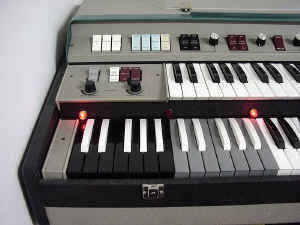 |
The Bass section lights. The two lit up here indicate the bass is switched for two octaves. (note the Grey Keys Selector tab is switched down, for Bass) |
(Thanks to David 'Egrefin' for these excellent Compact Duo pics. More available here at his website)
Controls
Lower manual voices:
Dolce 8’, Principale 8’, Ottava 4’
Vibrato: Slow/Fast, Light/Heavy, Vibrato
Off/On
Reverb:
Off/On
Tremolo:
Lower manual Off/On, Upper Manual Off/On,
Speed (knob)
Repeat/Percussion: Lower Manual Off/On, Upper Manual
Off/On, Repeat Speed(knob), Repeat/Percussion, Percussion Length(knob)
Multi-Tone Booster: 16', 8', 4',
2-2/3', All Booster Off/On, Multi-Tone Booster
Off/On
Voice Tabs: Bass 16', Strings 16', Flute 8', Oboe 8',
Trumpet 8', Strings 8', Flute 4', Strings 4', 2-2/3'
Brilliant Tab
Grey Keys Selector: Treble/Bass
Pedal Bass Manual Soft/Sharp
Percussion: Off/On,
Long/Short
Knobs: Bass Manual Balance, Lower Manual Balance
The DIN socket on the pedal may be 3-pin or 5 pin, but only 3 pins are used. The plug from the organ is always a 3-pin, which fits fine into either socket. Pins 1 and 2 carry the 12 volts to drive the lamp, pin 3 and the shield connect to the LDR for varying the volume. Here's a snippet from the schematics:
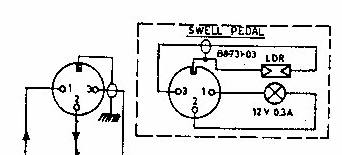
To use a standard volume pedal (i.e.,just a pot, no light bulb/photoresistor) with a Compact, just connect pin 3 and the shield, and leave pins 1 and 2 disconnected (but tape them up securely - don't let them touch anything, or it might go POW!) I just wired a standard 1/4 plug to mine, and plugged it into the OUTPUT side of a plain old passive in-line volume pedal. Of course, you give up the durability and noiselessness of the optical pedal this way, but in a pinch...
The Compact Pedal can also be used with a FAST-3 (and vice-versa) and at least some of the VIP series.
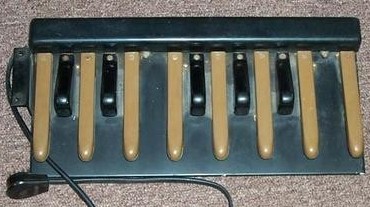 |
Typical set of Compact Bass Pedals. Note the bracket on the left with two holes - that's for hooking to the bottom of the stand (just like on the volume pedal). It's adjustable and removable, so some pedals may not have it FAST bass pedals look the same, but they're grey instead of tan. Interesting thing about these - note there are 13 pedals, but on the Compact, the Black bass octave is only 12 keys. So on a standard Compact (w/o the Grey octave), the pedalboard can play one note, the rightmost "C", that's unobtainable from the keyboard itself! |
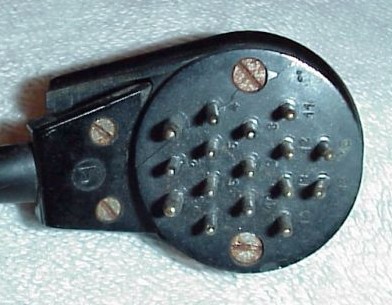 |
The 16-pin plug. I think this same plug was used on the bass pedals for most, if not all, Farfisa combo organs (But I don't think they're all interchangeable). The connector is a Hirschmann MES160. I don't think it's made any more. If anyone knows of a source I'd be interested in hearing about it. |